Bobby Vodnik
By Bud De Boer
In the nine years he spent in the sport, Bobby Vodnik drove for such notables as Joe Bush, Jim Lang, Lyle Fisher, John Loukas, Chris Karamesines, Kenny Hirata, Dick Belfatti, Masters & Richter, Bud Roche & Don Mattison, and Gordon Collett. Then at just 24 years of age, he decided to retire from active competition, as family responsibilities and a full time job became his number one priority. But what a career he had, the highlights of which included winning Top Eliminator at the U. S. Nationals in 1963.
Right from the start, Bobby’s excursions in straight-line racing were with one thought in mind “How do I win this race and move on to the next?” Whether it was in pre-race preparation or after it was over, nothing seemed to rattle him. After all, he had learned that from one of the best... Chris Karamesines!
EARLY YEARS:
Though born on October 18, 1943 in Blue Island, Illinois, Vodnik spent his childhood years growing up in nearby Oak Forest, where among other things he attended grade and high school. He was never into street racing or car clubs like many who grew up during that era. His “need-for-speed” was fulfilled later while driving some of best cars in the sport.
FIRST DRAG RACE ATTENDED:
In August 1958 at the World Series of Drag Racing in Cordova, Illinois, Bobby planned to “sleep out” on Saturday night after the races, using mother earth as a mattress. But it rained, forcing him to seek shelter and he did so in the trunk of a ’58 Corvette. Though were sure that GM never designed the car for that purpose, it must have been comfortable, because according Vodnik, “I woke up in the same position I went to sleep in." He also went on to say, “It was good times and great racing.”
FIRST CAR DRIVEN:
One day in 1959 while at the drag strip in Oswego, Illinois, friend Dale Davies, who had a B-gas dragster, asked Bobby if he’d make a run with the car. It had a Ray Muller chassis with a carbureted small block Chevy for power. So Vodnik strapped himself in and clicked-off an 11.80-second pass. He feared the worst but gave it his best and the result was Low ET of the meet for that day.
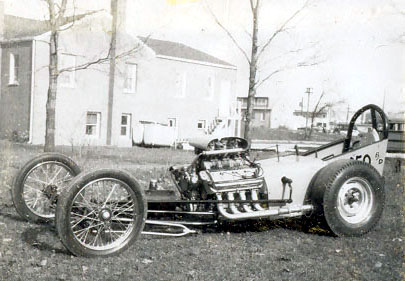 |
| 1960... Campaigned as a B-Gas dragster that Bobby Vodnik, Larry Reimer, and his uncle Jim DeVos put together, this home-built car featured a 354 hemi with six 2-barrel carbs and a Packard transmission. It saw action at tracks like U.S. 30, Union Grove, and Oswego with Vodnik and Reimer sharing the driving chores. |
OTHER CARS DRIVEN THROUGHOUT CAREER:
1960
…Vodnik along with Larry Reimer and his uncle Jim Devos finished building a dragster they started a year earlier. It was home-built car put together with lots of pride and sweat. Power came via a 354 hemi with six two bbl carbs coupled to a Packard transmission. It provided the trio with plenty of experience to learn what 1320 life was all about. With Reimer and Vodnik sharing the driving chores, they ran at tracks like U.S. 30, Oswego, and Union Grove.
In fact, they even got paid $25.00 to run at the McBride track in Michigan, where the only record they set was sleeping five people in his uncle’s ’59 Ford -- one in the front seat, one in the back seat, and three in the trunk. At the end of the season, they decided to “move on” as far as dragster chassis were concerned. Their home-built car was put on the scrap heap and a new Chassis Research TE-440 kit was ordered to take its place. Over winter of ’60 and ’61, the new car was welded together. 1961 presented a whole new ball game for the team, where in mid-year they switched from gas to nitro.
1961
... The season began with new injected hemi A/Gas dragster that as Vodnik said, “Looked as good as the Greek’s Chizler.” The new car ran consistently in the low 10s with speeds approaching 140 MPH, and once again, Reimer and Vodnik shared time in the driver’s seat. Then in July, Joe Bush of Speed Sport Automotive came forward with a deal that put a blown fuel hemi in the car. A decision was also made at that time to have Vodnik be the primary driver. To say the switch in fuel types was a success would be putting it mildly.
The second week out in Oswego, Illinois, they clicked off a track record 8.82 seconds at 180 MPH. The team also made mention that if the chassis had been longer and the engine set back more, the car probably would have run better. They continued to compete at local tracks for the remainder of the season. In addition, they also won a trip to the Bakersfield March Meet for 1962. That happened at the Top 20 event, which was held late that year in Oswego, Illinois. In addition to all the honors that went with doing well at this race, twenty cars from the Midwest received money to help with expenses for the trip to the west coast.
1962
... It began as the team journeyed to Bakersfield in March. But things didn’t go well, as they lost in the first round of eliminations due to a broken blower drive chain. The following week in Tucson, Arizona, was much better for the group as they won Top Eliminator, beating the Speed Sport rail in the final. Then in June of that year, Lyle Fisher brought both the Speed Sport roadster and the Speed Sport rail to Chicago. He offered Vodnik a job driving the dragster, providing Fisher could book dates running the two cars against each other. It was a chance for Vodnik to strike out on his own and he was ready for the challenge.
The first time he drove the rail was at Sanford, Maine, where he set a new track E.T. record of 8.16 seconds, which lasted for nearly two years. In addition to driving the rail, he also found seat time in John Loukas’ AA/Fuel coupe. In fact, at the World Series of Drag Racing in Cordova that year, Bobby was runner-up in it. Then in November, he once again made the trip west. This time it was to live with Lyle and Red Greth and work on their roadster, rail, and turbine car.
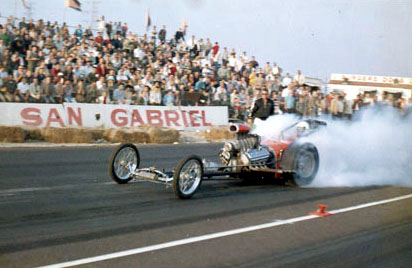 |
| 1962… At San Gabriel, CA, Vodnik puts Lyle Fisher’s “Speed Sport” rail through its paces during an 8.52 second-178 MPH run. |
The team also traveled throughout the Southwest, racing at tracks in California, Texas, and Arizona, and when traveling on the road like this group did, some rather unique experiences can happen. Like the time they were racing in San Gabriel, California and Jim Ward invited them to spend the night at his place. It didn’t seem like anything out of the ordinary. Just one racer helping another, except the house Ward occupied at the time was condemned and there was no electricity or hot water.
1963...
The holidays came and went, after which Vodnik was unable to find work and was running low on funds. Not a good position for anyone to be in, especially when you’re miles away from home. A ride back to Chicago from Arizona with Chris Karamesines and Don Maynard lifted his spirits somewhat, but not for long. With temperatures hovering near zero every day in the Windy City, he wanted out of the cold weather for the present. So he made a deal with Jim Lang to drive his car at the AHRA Winter Championships, which were scheduled in Phoenix at the end of January.
Meanwhile, Karamesines asked Vodnik if he would help prepare a new Rod Stuckey car that he and Maynard were slated to run at the upcoming AHRA winter meet. However, the trip to Arizona was a tragic one for Don Maynard. Traveling with Kenny Hirata and Phil Hobbs, a car accident along the way not only claimed Don’s life, but seriously injured Kenny and Phil as well. Maynard, one of the most respected tuners of his time, especially when it came to fuel burning hemi engines, is still talked about today in terms of “what might have been” if he were still competing. After the AHRA event, Vodnik stayed with the Greek and crewed for him during the remainder of his West Coast Tour.
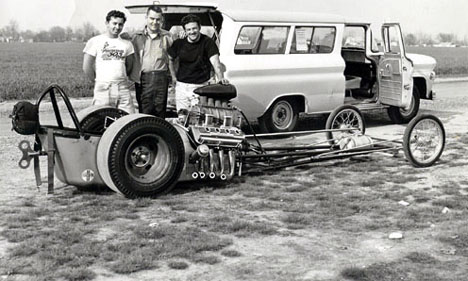 |
| 1963… Early in the year at Alton, IL, Vodnik took the helm of Chris Karamesines’ fabled “Chizler” top fueler to successfully defend the Greek’s spot on the Drag News Top Ten List. Here chassis builder Rod Stuckey (center) joins Bobby and Chris for a pre-race photo. |
Returning to Chicago in early spring, Bobby soon found himself at the helm of another Top Fuel car. This time it was the legendary “Chizler” and the track was Alton, Illinois, where he successfully defended Chris’s spot on the Drag News Top Ten List with two straight wins in a best of three go. Then it was on to driving two more cars for the remainder of the season. One was the gas dragster of Kenny Hirata and other was a fuel car named “The Shadow” that belonged to Dick Belfatti.
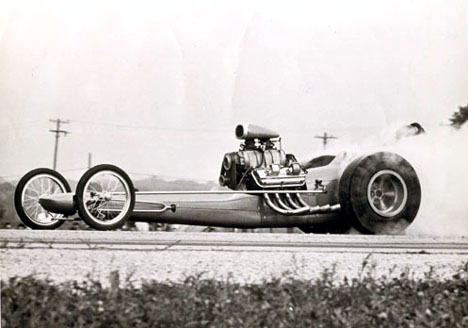 |
| 1963… At one of their many match race dates on the east coast during the summer, Vodnik drives Dick Belfatti’s “Shadow” to an 8.15 second-188 MPH clocking. |
Vodnik spent a month out east with Belfatti doing match races and then went back to Chicago to drive Hirata’s car at U.S. 30. In fact, over the 4th of July weekend at West Salem, Ohio, he drove both cars, taking one to a win in Top Gas over Gordon Collett and the other to a runner-up to Don Garlits in Top Fuel.
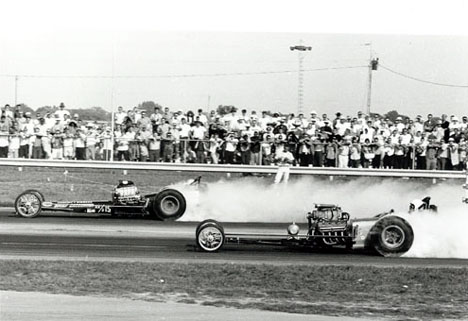 |
| 1963… At the U.S. Nationals in Indianapolis, Bobby Vodnik (near lane) in Kenny Hirata’s car took home Top Eliminator honors when he defeated a red-lighting Don Garlits, 8.62-174.75 to an 8.65-177.26. |
But as Vodnik said, “My big day came in September that year when I went home top dog at the U.S. Nationals.” It was the first time that NHRA had used the new Christmas Tree starting system and Bobby had studied it carefully throughout the event. He anticipated just how soon he could leave the starting line without red lighting. Prior to the final run, Don Garlits paid a visit to Hirata’s pit area, hoping to rattle a young Bobby Vodnik before the race. But it was to no avail as Vodnik told him, “I’ve been around the Greek too long to let you bother me.”
Garlits then asked if he planned to leave on the light again as he had done in previous rounds. Vodnik replied, “When I get to the line and let the clutch out, that’s exactly when I will leave.” According to Vodnik, “All Don could do was hang his head down and walk away,” while Hirata was thoroughly enjoying the encounter between the two. “Of course, the rest is history,” as Vodnik said, “Garlits red lighted and I won the ‘63 U.S. Nationals.”
1964...
Bobby teamed up once again with Dick Belfatti while Phil Hobbs returned to the driver’s seat in Kenny Hirata’s gas dragster. Also, Belfatti had commissioned Fred Allen of Philadelphia to build him a Rod Stuckey look-a-like car and that wouldn’t be done until April. So in January, Vodnik left for the West Coast with hopes of finding a temporary ride at some of the winter meets.
One did come his way. Bobby got a ride in the Master & Richters fueler, thanks to the help of Howard Johansen of Howard Cams. At the Winternationals, Vodnik set a new speed record of 191 MPH. In the first round of eliminations he faced Don Garlits, who red-lighted his chances away of continuing any further. However, what should have been an easy win Vodnik wound up being a disqualification as he hit the mag switch after releasing the brake handle, thus killing the engine and forcing him to turn off track before the end of the quarter-mile.
April rolled around and Belfatti’s new car was ready. They had a match race against Joe Shubeck in Niagara Falls, New York, where they not only beat “Gentleman Joe” two straight in a quarter-mile shootout, but also set a new track record of 187 MPH in the process. Also in April, Vodnik won a very prestigious honor when the New York Auto Racing Fraternity named him “Drag Race Driver of the Year.”
Come May, Vodnik and Belfatti went on a tear, setting track records wherever they appeared. On May 16, they turned a 7.96 at Cecil County, Maryland, and according to Vodnik, “We were the first ones to hold a national record below eight seconds.” He also said, “The car left good and we carried the front wheels six inches off the track for the entire quarter mile.” But they lost a blower on that run and were unable to better the record. On Memorial Day weekend at Union Grove, they won both Friday and Saturday nights but lost in finals on Sunday due to a bad pair of borrowed slicks.
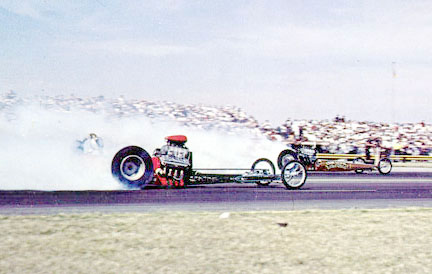 |
| 1964… Once again at the U.S. Nationals, Vodnik (near lane) in Dick Belfatti’s “Shadow” does some side-by-side qualifying with Connie Kallitta. |
By the middle of the season, Vodnik and Belfatti held five state speed records at one time (New York, Pennsylvania, Connecticut, New Jersey, and Ohio). At the ’64 U.S Nationals, they went out in the first round to Jack Williams, the eventual winner of the meet.
1965…
Vodnik and Belfatti started their West Coast Tour with the ’64 car, but due to a bad blower, were unable to qualify at either the AHRA or NHRA Winternationals. From there, they proceeded to Kent Fuller’s shop in Northern California to pick up a new car. The first weekend racing it, they took home runner-up honors at Fremont. The second week out, they won at Long Beach and doing so, Vodnik became the third out-of-state driver ever to win a race at “The Beach.” On Sunday, they traveled to Fontana, were they were runner-up to the Surfers (they lost a bearing). With Bakersfield coming up, they completely rebuilt everything, including engine, blower, clutch, etc. They wanted to pull into Famoso Raceway for the March Meet “loaded for bear.”
On the first run at Bakersfield, they laid down a 7.32 ET, which was nearly three tenths quicker than the next best time of 7.60. But Vodnik said, “I really believe that it ran the time because I slid and clutch and barely hazed our new M & H tires.” However, the team paid the price by losing a couple of pistons and they had to put their spare engine in the car. But the breakage didn’t stop there; it continued into the first round of eliminations where they put another motor out of commission, thus ending their West Coast Tour.
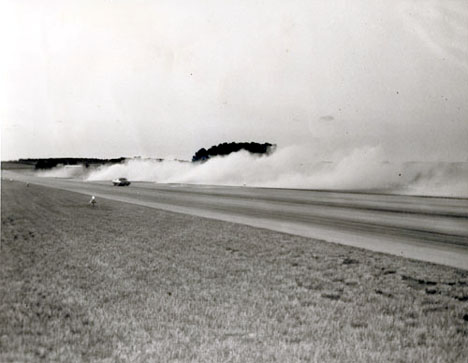 |
| 1965… Billed as a “Rocket Powered Dragster,” driver Bobby Vodnik puts Dick Belfatti’s “Shadow” through some “1320 Showmanship” at York, PA. Using a combination of smoke from the from the rear slicks, a special chemical sprayed from a pressurized propane tank, and exhaust pressure from the car’s zoomies, they were able to produce a thick cloud of smoke that went some 30 feet in the air. As Vodnik said, “It drove the crowd wild.” |
Come April, the team was back in familiar territory, traveling to match race dates throughout the Midwest and East Coast, running ETs in the 7.70s and speeds in the low 200s. At the U.S Nationals time at IRP, they lost to the Hawaiian on Sunday (fuel pump drive) and Garlits in the first round on Monday when Big Daddy just outran them. Also in 1965, Bobby married his wife Sarah and moved back to Chicago after the racing season.
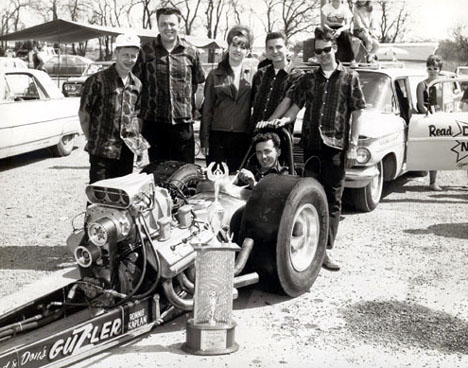 |
| 1966… A change in rides found Vodnik behind the wheel of the “Guzzler” AA/Fuel dragster. Seated in the car, he shares the Winner Circle along with (L-R) Don Mattison, Bud Roche, Gail Czarnowski, Harold Brewer, and Fred Brewer, after taking top honors at the Drag News Invitational. |
1966...
Vodnik joined another team from the Chicago area, namely Bud Roche, Don Mattison, and their hard running “Guzzler” fuel car. The team competed in match races in the Midwest and East, beating names like Ivo, Prudhomme, and Kalitta along the way. In addition to their match races, the team also won the Drag News Invitational event at U.S 30 Dragway in Gary, Indiana. They also made a blistering run of 225 MPH at Rockford, Illinois. After the July 4th weekend, Bobby told Bud and Don that he would like to take a break from driving until after his daughter was born on August 9. The Guzzler team couldn’t wait until then, so they hired another driver to take his place.
Come Indy time, Vodnik was without a ride and he went there to spectate on Monday. But it didn’t take long before people became aware of his presence. Gordon Collett asked Bobby to drive his car during eliminations that day. On Vodnik’s first run in the dragster, he trimmed nearly a tenth of a second off Collett’s best ET of the weekend with an 8.23-second clocking. Vodnik got as far as the semi-finals, where he lost when his clutch-sliding style of driving warped the aluminum flywheel.
1967...
Bobby had started a new job, but continued do weekend racing with familiar car owner and tuner Ken Hirata, who had installed a late model 426 style hemi in his gas dragster. The car made a lot of power when it ran good, but there were too many engine failures. Vodnik said, “The engine’s rods were too short, which caused the pistons to be top heavy.”
The breakage forced a rather unsuccessful season as far a drag racing was concerned. On top of that, the new job Vodnik had started earlier was now a mandatory six days a week. So with that in mind and a family started, Bobby Vodnik decided to retire from active competition. It had been a “good ride” during the nine years he spent in the sport. It was a trip that took him through the Golden Years of drag racing and we thank him for making the journey.
WHAT ARE YOU DOING TODAY:
Bobby is currently a mold maker at Panduit Corporation in Tinley Park, Illinois, where he has worked in the Tool & Die trade for 39-1/2 years, making injection molds. Vodnik has been married over 40 years to his wife Sarah. He has three children and five grand children with one on the way. Bobby still attends races at Joliet, Indy, and Bowling Green.
HOW YOU’D LIKE TO BE REMEMBERED FOR YOUR CONTRIBUTIONS TO THE SPORT:
I, along with the car owners I drove for, brought professional top fuel racing and showmanship to tracks in the East and Midwest that some other drivers would not consider racing on. Tracks that were either too short, too narrow, too rough or all of the preceding. I would also like to say a special thanks to all the car owners and sponsors that allowed me to fill my need for speed, travel, and adventure, which I would have not been able to afford on my own at ages 15 thru 23.
PHOTO CREDITS:
George Horton, Robert Snayko, Larry Nixdorf, Peter Pearson, and The Bobby Vodnik Collection.